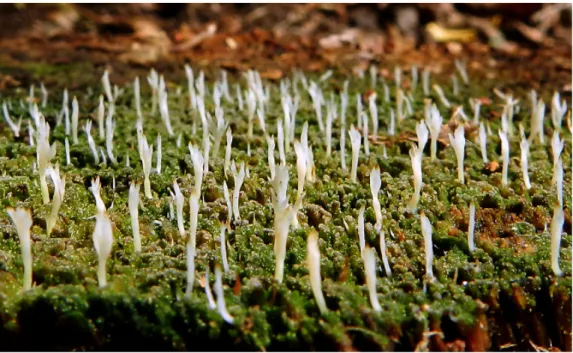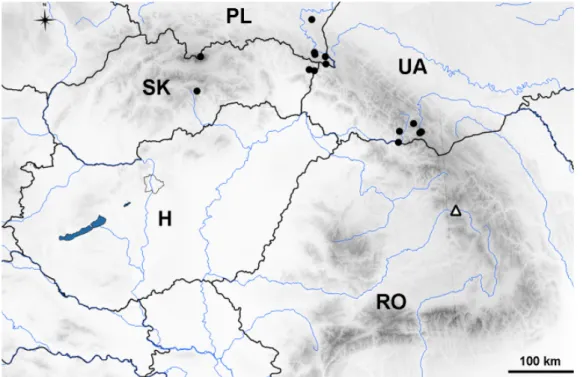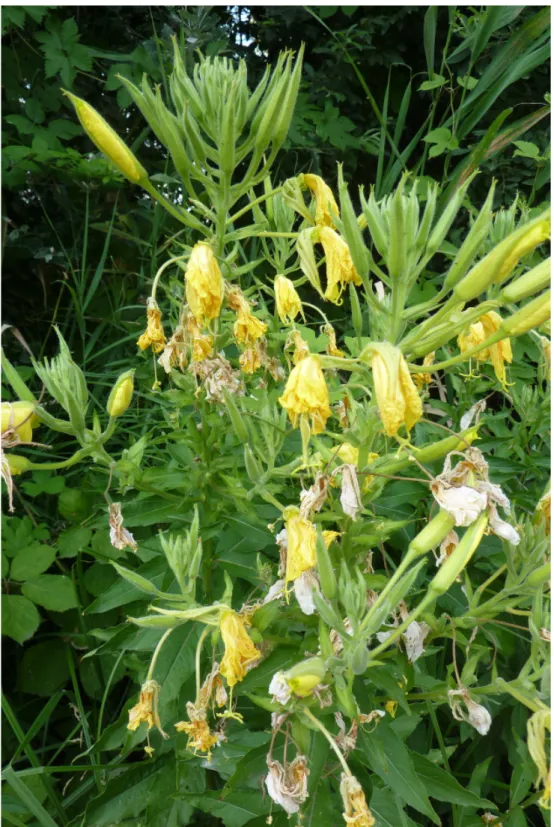TAXONOMICAL AND CHOROLOGICAL NOTES 6 (71–74)
Dávid Schmidt
1*, János Csiky
2*, Gábor Matus
3*, Rebeka Balogh
3, Erzsébet Szurdoki
4, Mária Höhn
5, Péter Ábrán
6, Krisztina Buczkó
4and László Lőkös
4*
1Institute of Botany and Nature Conservation, University of Sopron, H–9400 Sopron, Bajcsy-Zsilinszky u. 4, Hungary; *schmidt.david@uni-sopron.hu
2Department of Ecology, Institute of Biology, Faculty of Sciences, University of Pécs, H–7624 Pécs, Ifj úság útja 6, Hungary; *moon@ttk.pte.hu
3Department of Botany, Institute of Biology and Ecology, Faculty of Science and Technology, University of Debrecen, H–4032 Debrecen, Egyetem tér 1, Hungary; *matus.gabor@science.unideb.hu
4Department of Botany, Hungarian Natural History Museum, H–1431 Budapest, Pf. 137, Hungary; *lokos.laszlo@nhmus.hu
5Department of Botany and Soroksár Botanical Garden, Faculty of Horticultural Science, Szent István University, Budapest, Hungary; hohn.maria@kertk.szie.hu
6Agenţia de Protecţie a Mediului Mureş, Târgu Mureş, Romania
Schmidt, D., Csiky, J., Matus, G., Balogh, R., Szurdoki, E., Höhn, M., Ábrán, P., Buczkó, K. &
Lőkös, L. (2018): Taxonomical and chorological notes 6 (71–74). – Studia bot. hung. 49(1): 121–130.
Abstract: Th e present part of the series of miscellaneous new records provides new chorological data of one lichen-forming fungus and three vascular plants. One basidiolichen species (Multicla- vula mucida) is reported for the fi rst time from the territory of Romania as native and one (Oeno- thera oehlkersii) from Hungary as a garden escape. One species (Dryopteris affi nis) is new for the Bakony Mts and one is confi rmed for the Great Hungarian Plain (Danthonia decumbens).
Key words: Clavulinaceae, Dryopteridaceae, Hungary, Onagraceae, Poaceae, Romania
INTRODUCTION
Th is paper is the sixth part of the series launched in Studia botanica hunga- rica focusing on the new chorological records, nomenclature, and taxonomy of plant species from algae to vascular plants and fungi (Barina et al. 2015, Csiky et al. 2017, Mesterházy et al. 2017, Papp et al. 2016, Takács et al. 2016).
MATERIAL AND METHODS
Nomenclature of vascular plants follows Király (2009) and Th e Plant List (2013).
Codes of the Central European fl ora mapping grid are in square brackets.
Coding of forest lots has been based on www.erdoterkep.nebih.gov.hu.
valley at the southwestern border of the Călimani Mts (Eastern Carpathians), ca 1.1 km ENE of Neagra, on heavily wet stump of a fallen coniferous tree, 46.969478° N, 25.170562° E, ca 725 m; leg.
L. Lőkös, H. Höhn and E. Szurdoki, 26.09.2017 [BP 96315].
Multiclavula mucida is a conspicuous, easily recognisable, crustose, basidio- lichen species (Fig. 1). Its thallus consists of tiny granules forming a thin, bright green (when wet) or greyish (dry) layer on the surface of the substrate. Fruit- bodies are ascending, small, 1–2 cm tall, cylindrical, club-shaped, simple or rare- ly branched, straight or curved, whitish or pale crème or ochre colour. Th e 4–6 basidiospores are produced by the basidia at the darker brownish, pointed tips of the basidiomata.
Multiclavula mucida has been reported from several countries in Europe, but only with a few records from most of the places. From the Carpathian re- gion it is known from Poland (Kościelniak et al. 2016), Slovakia (Guttová
Fig. 1. Multiclavula mucida, thallus and fruit-bodies (Photo: E. Szurdoki).
and Palice 1999) and Ukraine (Holec 2008, Pilát 1940, Vondrák et al.
2010) (Fig. 2). It is considered as the fi rst Romanian record (cf. Ciurchea 2004, Eliade 1965), which is ca 130 km far from the closest known localities in the Ukrainian Carpathians (Maramaros Mts). Th is occurrence has already been an- nounced recently in a poster presentation without exact locality information (Lő kös et al. 2018).
L. Lőkös, E. Szurdoki, M. Höhn, P. Ábrán and K. Buczkó Pteridophyta
(72) Dryopteris affi nis (Lowe) Fraser-Jenk. (Dryopteridaceae)
Hungary, Győr-Moson-Sopron County, Bakonyalja: Fenyőfő, North from the village, in a Pinus sylvetris dominated forest (plantation), at the edge, close to the forest road, 47° 21’ 5.46” N, 17° 45’ 32.73” E, 267 m [8672.2]; leg. Csiky J. and Csikyné R. É., 11.05.2018, det. Csiky J. (photo- documented) (Fig. 3).
Th is native and expansive fern was thought to be rare with some occurrenc- es in the Transdanubian half of the country in the last century (Farkas 1999).
Nowadays (Bartha et al. 2015) it is widespread in West and South Transdanubia, but small populations are also known in the Gerecse Mts (Barina 2006), Buda
Fig. 2. Known occurrences of Multiclavula mucida in the Carpathian Mts (dots) and the new local- ity (triangle) (Guttová and Palice 1999, Holec 2008, Kościelniak et al. 2016, Pilát 1940, Vondrák et al. 2010) (H = Hungary, PL = Poland, RO = Romania, SK = Slovakia, UA = Ukraine).
Fig. 3. Dryopteris affi nis at Fenyőfő (Photo: J. Csiky).
With its single, but strong specimen on the edge of the so called “Fenyőfői Ős- fenyves” it contributes to the local list of mountain species, which prefer moist and shady habitats, typical for conifer forests and plantations in Hungary. Associated herb species within 1 m
2are ruderal taxa and/or plants preferring nutrient rich soils: Anthriscus cerefolium, Chelidonium majus, Dryopteris fi lix-mas, D. carthusi- ana, Geranium lucidum, Poa pratensis, Rubus caesius, Rubus sp., Urtica dioica.
J. Csiky Vascular plants
(73) Danthonia decumbens (L.) DC. [syn.: Sieglingia decumbens (L.) Bernh.]
(Poaceae)
Hungary, Great Hungarian Plain (Nagyalföld), Dél-Nyírség micro-region, Vámospércs: Villon- gó, N 47.53319°, E 21.95055°, 132 m, leg. G. Matus, R. Balogh, I. Rácz, F. Báthori, 08.08.2017, det. G.
Matus [8497.4], in moist sandy grassland, DE-Soo-45642, BP HNHM-TRA 00012375; – Monostor- pályi: Monostorpályi-legelő, N47.41197°, E21.77720°, 111 m; det. G. Matus, R. Balogh, 14.06.2018, in mesic meadow [8596.4]; – Létavértes: Létai-legelő, a) N of 108/B forest lot, N47.44091°, E21.91176°, 118 m, 30.06.2017, leg. G. Matus, R. Balogh, K. Varga, Cs. Farkas, det. G. Matus [8597.3] and b) NE of 108/A forest lot, N47.44459°, E21.91787°, 118 m, leg. G. Matus, R. Balogh, det. R. Balogh, 06.07.2017 [8597.4], both in shallow depressions among sand dunes, DE-Soo-45643, BP HNHM-TRA 12373.
Th e common heath grass is native to Europe, the Azores and the Madeira Islands, North Africa (Morocco, Algeria, and Tunisia) and parts of western Asia (Turkey, Georgia). Aft er introduction it is naturalized in some temperate regions of Australia, New Zealand, and North (USA) and South America (Chile) but rarely reported as invasive (Alfonso 2010, Mallett 2005, https://www.cabi.org/isc/da- tasheet/113791). In Hungary, where the acidophilous subsp. decumbens is present (Soó 1973), it is widespread in West Hungary and present in Bakonyalja and the Vértes Mts. In South Hungary it is present in Belső-Somogy (on acidic sand) and the Mecsek Mts (Csiky et al. 2014). It also occurs in the Visegrád Mts and in all those regions of the North Hungarian Mountain Range where acidic bedrocks are present (Csiky 1999, Simon 1992, Soó and Kárpáti 1968). In contrast, in lowlands, only sporadic records are known from the southern edge of the Small Hungarian Plain (Vitnyéd, Csapod, Röjtökmuzsaj) as well as Drávamenti-síkság (Endrőc, Csiky 2005). In the Great Hungarian Plain (Alföld) no data had been reported till the early 1980s (Boros 1932, Soó 1973, Soó and Kárpáti 1968).
Th e species was fi rst collected in the Great Hungarian Plain in the Nyírség,
a sandy region split between Hungary and Romania, by Z. Siroki at Vámospércs
(HU) [8497.4] in 1984–1985 (Simon 1992, as DE–siroki–011668–01672.jpg in
Takács et al. 2015). No record has been published yet from the Romanian part of
the region (Karácsonyi 1995). Records close to those in the Nyírség were doc-
umented in the Mátra Mts, the Bükk Mts, Bükkalja and the Zemplén Mts (HU)
apping neither reviewed the available literature. In 2017 and 2018 we confi rmed the presence of the species near the original site of Vámospércs and recorded it from three further grid cells near Monostorpályi and Létavértes. Further occurrences in the Nyírség along the Kék-Kálló stream (HU) as well as in the Romanian part of the Nyírség (Cimpia Nirului) are likely in similar habitats as near the Ér brook.
Some newly collected specimens have been deposited at BP and DE, respectively.
Th e species in Hungary is known as typical of acidic mountain meadows as well as heathlands. It is considered as Nardetalia species present most of- ten in Nardo-Festucetum ovinae and in acidic fen and marsh meadows Junco–
Molinietum, Deschampsietum cespitosae as well as in fens (Carici echinatae-Sphag- netum, Caricetum davallianae) and several other grassland and forest commu- nities such as Th ymo-Festucetum ovinae, Quercetum paetraeae-cerris, Aulocomnio- Pinetum sylvestris, Festucetum pratensis, Lolio-Cynosuretum, Genisto pilosae-Fes- tucetum ovinae, Festucetum rubrae (Simon 1992, Soó 1973).
All Nyírség habitats proved to be temporarily moist acidic grasslands and meadows in shallow dune slacks on calcium-free, acidic sand. Soil traits at Létavértes a) are as follows at the 0–10 cm layer, pH(KCl): 4.2, organic material (m/m)%: 4.7, P
2O
5(mg/kg): 73, K
2O (mg/kg): 185.
Matus, G. and Balogh, R.
(74) Oenothera oehlkersii Kappus ex Rostański (Onagraceae)
Hungary, Veszprém county, Balatonkenese, “Kikötő street” 47° 01’ 54.4” N 18° 06’ 14.4” E, a few specimens in a ruderal place; leg.: D. Schmidt, 04.07.2015 (8974.4), photodocumented (Fig. 4).
Oenothera oehlkersii is a presumed hybrid between Oe. glazioviana and Oe.
suaveolens, which is originated in Europe (Rostański et al. 2010). Its main char-
acteristics are the yellowish green fl ower bud and the stigma which hangs out of
the fl ower (longer than the petals). Th e stigma of Oe. suaveolens is signifi cantly
shorter, however, it is much less glandular but white hairy, and the fl owers are
smaller than Oe. oehlkersii. Oe. glazioviana has got red stripped fl ower bud and
sepal, furthermore the colour of the stem and the rachis is also red. In contrast,
Fig. 4. Oenothera oehlkersii at Balatonkenese (Photo: D. Schmidt).
scribed it as a cultivated plant, which escapes very rarely. In Balatonkenese, it grows close to the gardens, but clearly in a wild plant community. None of the parents were observed in the broader verge of the location. According to Rostański et al. (2010) it occurs in the wild in eight European countries, mostly in the western part of the continent. In Central Europe it is known only in Slovakia and Poland (Wolanin and Woźniak 2011). Neither in the critical revision and synthesis of the Hungarian Oenothera species published by Rostański (1966), nor in the rel- evant checklist of neophytes (Balogh et al. 2004) no mention of Oe. oehlkersii can be found, therefore Oe. oehlkersii is a new alien species in the fl ora of Hungary.
D. Schmidt
* * *
Acknowledgement – Th e fi eldwork of Lőkös L. et al. was supported by the project NKFI K119208.
Összefoglaló: A sorozat jelen részében egy zuzmó és három edényes növény új adatait kö- zöljük. Egy őshonos, bazídiumos zuzmófajt (Multiclavula mucida) elsőként közlünk Románia te- rületéről, egy kerti szökevényt (Oenothera oehlkersii) pedig Magyarország területéről. Egy fajt új- ként jelzünk a Bakony (Dryopteris affi nis) területéről, egy (Danthonia decumbens) előfordulását pe- dig megerősítjük a Nyírség területén.
REFERENCES
Alfonso, Y. (2010): Danthonia decumbens. AusGrass2. – In: Simon, B. K. and Alfonso, Y. (eds):
AusGrass2 http://ausgrass2.myspecies.info/content/danthonia-decumbens
Balogh, L., Dancza, I. and Király, G. (2004): A magyarországi neofi tonok időszerű jegyzéke és besorolásuk inváziós szempontból. – In: Mihály, B. and Botta-Dukát, Z. (eds): Biológiai inváziók Magyarországon. Özönnövények. TermészetBÚVÁR Alapítvány Kiadó, Budapest, pp. 61–92.
Barina, Z. (2006): A Gerecse hegység fl órája. – Rosalia, Magyar Természettudományi Múzeum–
Duna–Ipoly Nemzeti Park Igazgatóság, Budapest, 612 pp.
Barina, Z., Benedek, L., Boros, L., Dima, B., Folcz, Á., Király, G., Koszka, A., Malatinszky, Á., Papp, D., Pifkó, D. and Papp, V. (2015): Taxonomical and chorological notes 1 (1–19). – Studia bot. hung. 46(2): 205–221. https://doi.org/10.17110/studbot.2015.46.2.205
Bartha, D., Király, G., Schmidt, D., Tiborcz, V., Barina, Z., Csiky, J., Jakab, G., Lesku, B., Schmotzer, A., Vidéki, R., Vojtkó, A. and Zólyomi, Sz. (eds) (2015): Magyarország edényes növényfajainak elterjedési atlasza. Distribution atlas of vascular plants of Hungary. – University of West Hungary Press, Sopron, 329 pp.
Boros, Á. (1932): A Nyírség fl órája és növényföldrajza. – Tisza István Tudományos Társaság Hon- ismertető Bizottságának Kiadványai VIII., Debrecen, 208 pp.
Ciurchea, M. (2004): Determinatorul lichenilor din România. – Editura BIT, Iaşi, 488 pp.
Csiky, J. (1999): Adatok a Karancs és a Medves fl órájához. – Kitaibelia 4(1): 37–43.
Csiky, J. (2005): Adatok Magyarország fl órájához és vegetációjához. – Kitaibelia 10(1): 138–153.
Csiky, J. and Somlyay, L. (2005): A Dryopteris affi nis (Löwe) Freser-Jenkins előfordulása a Budai- hegységben. – Kitaibelia 10: 201.
Csiky, J., Erzberger, P., Kovács, D. and Deme, J. (2014): Short notes 5. Campylopus pyriformis (Schultz) Brid. in the Western Mecsek Mts (South Transdanubia, Hungary). – Kitaibelia 19(2): 365–370.
Csiky, J., Kováts, D., Deme, J., Takács, A., Óvári, M., Molnár V., A., Malatinszky, Á., Nagy, J. and Barina, Z. (2017): Taxonomical and chorological notes 4 (38–58). – Studia bot.
hung. 48(1): 133–144. https://doi.org/10.17110/studbot.2017.48.1.133
Eliade, E. (1965): Conspectul Macromicetelor din România. – Acta Bot. Horti Lucr. Grăd. Bot.
București 1964–1965: 185–324.
Farkas, S. (ed.) (1999): Magyarország védett növényei. – Mezőgazda Kiadó, Budapest, 419 pp.
Guttová, A. and Palice, Z. (1999): Lisajníky Národného parku Muránska planina I. Hrdzavá doli- na. [Lichens of National Park Muránska planina I. Th e Hrdzavá dolina Valley]. – In: Uhrin, M. (ed.): Vyskum a Ochrana Príody Muránskej Planiny 2. Revúca, pp. 35–47.
Holec, J. (2008): Interesting macrofungi from the Eastern Carpathians, Ukraine and their value as bioindicators of primeval and near-natural forests. – Mycol. Balcan. 5: 55–67.
Karácsonyi, C. (1995): Flora şi vegetaţia judeţului Satu Mare. – Edit. Muzului Sătmărean, Szat- márnémeti, 181 pp.
Király, G. (ed.) (2009): Új magyar füvészkönyv. Magyarország hajtásos növényei. Határozókulcsok.
– Aggteleki Nemzeti Park Igazgatóság, Jósvafő, 616 pp.
Király, G., Virók, V. and Molnár V., A. (eds) (2011): Új magyar füvészkönyv. Magyarország haj- tásos növényei. Ábrák. – Aggteleki Nemzeti Park Igazgatóság, Jósvafő, 676 pp.
Kościelniak, R., Betleja, L. and Baran, D. (2016): Multiclavula mucida – an epixylic lichen of natural forests in south-eastern Poland. [Multiclavula mucida – epiksyliczny porost natural- nych lasów w Polsce południowo-wschodniej]. – Roczniki Bieszczadzkie 24: 47–52.
Lőkös, L., Szurdoki, E., Höhn, M., Ábrán, P. and Buczkó, K. (2018): A Multiclavula mucida első adata Romániából. (Th e fi rst record of Multiclavula mucida fr om Romania). – In: Molnár, V. A., Sonkoly, J. and Takács, A. (eds): Programme and abstracts, 12th International Conference, Advances in research on the fl ora and vegetation of the Carpato-Pannonian re- gion, Debreceni Egyetem, TTK, Növénytani Tanszék, Debrecen, p. 78.
Mallett, K. (2005): Flora of Australia Volume 44B: Poaceae 3. – CSIRO Publishing / Australian Biological Resources Study (ABRS), Melbourne, Australia, 486 pp.
Matus, G. and Papp, M. (2001): Újabb adatok a bagaméri Daruhegyek (Dél-Nyírség) fl órájához.
– Kitaibelia 6(2): 363–369.
Matus, G. and Papp, M. (2003): Adatok Hajdúsámson és Vámospércs környékének (Dél-Nyírség) fl órájához. – Kitaibelia 8(1): 99–112.
Mesterházy, A., Matus, G., Király, G., Szűcs, P., Török, P., Valkó, O., Pelles, G., Papp, V.
G., Virók, V., Nemcsok, Z., Rigó, A., Hohla, M. and Barina, Z. (2017): Taxonomical and chorological notes 5 (59–70). – Studia bot. hung. 48(2): 263–275.
https://doi.org/10.17110/studbot.2017.48.2.263
of Sciences, Kraków, 157 pp.
Simon, T. (1992): A magyarországi edényes fl óra határozója. – Tankönyvkiadó Vállalat, Budapest, 892 pp.
Schmotzer, A. (2015): Ceratocephala testiculata (Crantz) Roth and further data to the fl ora of the foothills of Bükk Mts. (‘Bükkalja’, NE Hungary). – Kitaibelia 20(1): 81–142.
https://doi.org/10.17542/kit.20.81
Soó, R. (1973): A magyar fl óra és vegetáció rendszertani-növényföldrajzi kézikönyve 5. (Synopsis sys te- ma tico-geobotanica fl orae vegetationisque Hungariae V.) – Akadémiai Kiadó, Budapest, 387 pp.
Soó, R. and Kárpáti, Z. (1968): Növényhatározó II. – Tankönyvkiadó, Budapest, 846 pp.
Takács, A., Baráth, K., Csiky, J., Csikyné, R. É., Király, G., Nagy, T., Papp, V., Schmidt, D., Tamási, B. and Barina, Z. (2016): Taxonomical and chorological notes 3 (28–37). – Studia bot. hung. 47(2): 345–357. https://doi.org/10.17110/studbot.2016.47.2.345
Takács, A., Nagy, T., Fekete, R., Lovas-Kiss, Á., Ljubka, T., Löki, V., Lisztes-Szabó, Zs.
and Molnár V., A. (2014): A Debreceni Egyetem Herbáriuma (DE) I.: A „Soó Rezső Her bá- rium”. – Kitaibelia 20(1): 15–22.
Takács, A., Süveges, K, Ljubka, T., Löki, V., Lisztes-Szabó, Zs. and Molnár V., A. (2015):
A Debreceni Egyetem Herbáriuma (DE) II.: A „Siroki Zoltán Herbárium”. – Kitaibelia 20(1):
15–22. https://doi.org/10.17542/kit.20.15
Th e Plant List (2013): Version 1.1. – Published on the Internet, http://www.theplantlist.org/ [ac- cessed on 07 November 2017].
Thiers, B. M. (2017): Index Herbariorum: A global directory of public herbaria and associated staff.
– New York Botanical Garden’s Virtual Herbarium. http://sweetgum.nybg.org/ih/ [accessed on 05 November 2017]
Valkó, O., Török, P., Tóthmérész, B. and Matus, G. (2010): Restoration potential in seed banks of acidic fen and dry-mesophilous meadows: can restoration be based on local seed banks? – Restoration Ecol. 19(101): 9–15. https://doi.org/10.1111/j.1526-100x.2010.00679.x Valkó, O., Török, P., Vida, E., Arany, I., Tóthmérész, B. and Matus, G. (2009): A magkészlet szerepe két hegyi kaszálórét közösség helyreállításában. – Term.véd. Közlem. 15: 147–159.
Vojtkó, A. (2001) (ed.): A Bükk hegység fl órája. – Sorbus 2001 Kiadó, Eger, 340 pp.
Vondrák, J., Palice, Z., Khodosovtsev, A. and Postoyolkin, S. (2010): Additions to the diversity of rare or overlooked lichens and lichenicolous fungi in Ukrainian Carpathians. – Chornomors’k. bot. zhurnal 6: 6–34.
Wolanin, M. and Woźniak, M. (2011): Oenothera oehlkersii Kappus ex Rostanski – a new evening-primrose species in Polish fl ora. – Biodiv. Res. Conserv. 23: 57–58.
https://doi.org/10.2478/v10119-011-0015-9



